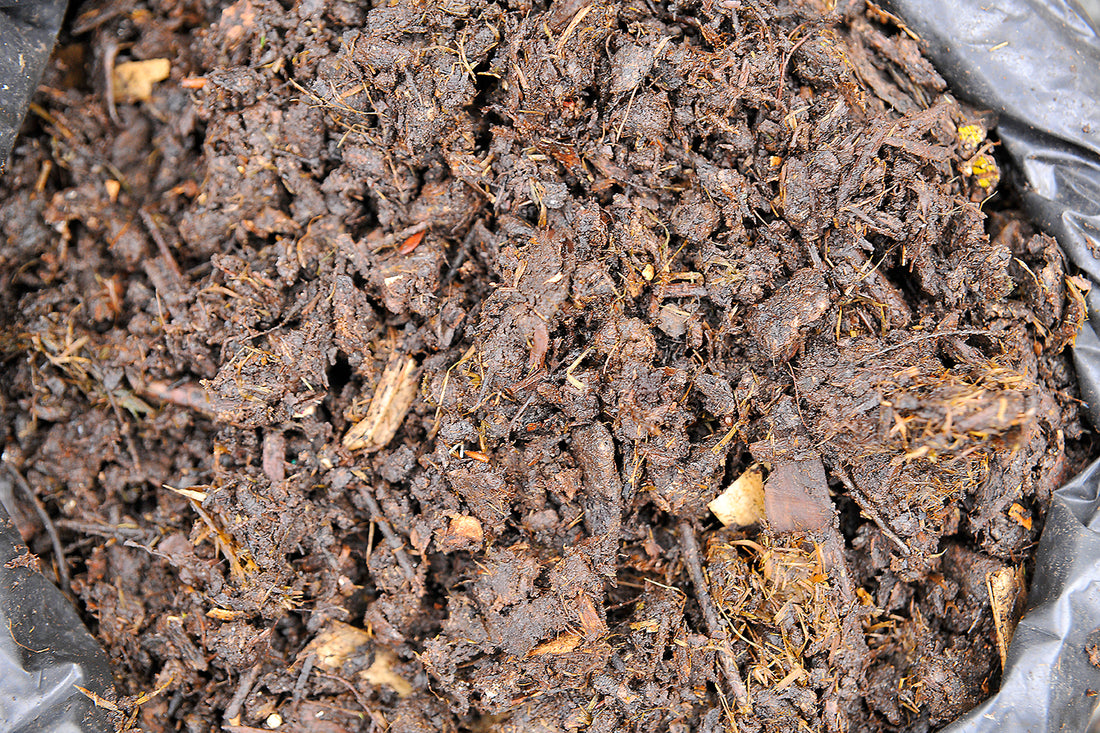It is important to understand that the term “compost” is used to describe many things. Compost is actually the brown stable organic matter remaining at the end of the decaying (composting) process. Pure compost is not the same as “multi-purpose compost”. However, on retail bagged products, compost is used to describe both the organic source matter used as a soil improver/additive and compost blended with other compounds i.e. soil (loam), sand and other ingredients to make a growing medium.
Peat, not to be confused as compost, is organic material that is ‘partially’ degraded. You can read more about peat and why the UK is seeking to ban the use of it here.
What are the Component Parts of Compost?
Compost consists of five major components: air, water, particles of degraded organic matter, humus and nutrients. The information in the following table relates to homemade compost from a compost heap or a HOTBIN which is free from soil, clay and other bits of non-organic matter.
|
|
% |
Notes |
|
|
Air |
Compost contains a surprising amount |
Typical density is 0.4-0.6 g/cm3 or 40-60%. |
|
|
Water |
|
Compost contains anywhere from 40% to 90% water |
|
|
Large Particles (>10mm) |
Large particles of degraded organic matter. (Homemade compost has more large bits - ‘bagged’ compost is sieved to remove these) |
Up to 75% |
Adds aeration. Too much and will lose water quickly |
|
Small particles (0.5 – 10mm) |
Small particles of degraded organic matter. |
98% -20% |
Adds aeration. |
|
Humus and colloidal humus (<0.5 mm) |
Humus particles are smaller than 0.5mm, a kitchen sieve can be used to give any home gardener a rough approximation of the humus content in their compost. |
1-5% (OM) |
Adds water retention – too much blocks aeration |
|
Nutrients (NKP) |
Nutrients are in two forms – plant ready (in water) and those slowly released over time as compost further decays. Compost has mainly the latter. |
1-2% |
Humus controls NKP release |
Many multi-purpose types of compost are blended mixes with fine particles of silt and clay added – these small particles pass through sieves, so the above analysis is not comparable.
What Goes in Compost? Types of Compost Bases
Non-homemade compost can have many different base types, from peat to wood fibre, here are some compost bases and additional elements that may feature in the blends.
|
Organic “Compost” Base |
Other Compounds in the Blend |
|
Peat |
Soil, loam, clays, minerals, sand, grit
Others – perlite, SAP gels, vermiculite, fytocel foam, NKP nutrients, slow release NKP pellets, biochar, carbon, rock wool, lime, rock flour (dust, aka silt).
|
Compost Bases Explained
- Green Waste Compost – industrial scale compost made from plant waste. In the UK, it will mainly be woody hedge and tree cuttings with a large amount of grass from council collections
- Food Waste and Green Waste – industrial scale, carried out under very strict conditions with the final compost tested and approved to PAS 100 standard for sanitisation etc. One of the ongoing debates around bought compost is the quality control around bits of plastic and other non-biodegradable stuff.
- Organic Compost – all compost is from natural plant and animal life. If you want compost to meet a specific ‘organic lifestyle’ standard, look for a kite mark – eg “soil assoc. approved”.
- Peat Free Organic Compost (PFOC) – 100% peat free, but can contain any item in the table above.
- HOTBIN Compost – homemade compost has one big advantage – you know what you put in and hence what will not be in the final compost!
Compost Suitability as a Growing Media
Many growing media seek to replicate the John Innes Institute Number 1, 2 & 3 blends for seed germination, plant plugs and trays etc; the mix ratios (of composts such as this) are approximately 7 loam: 3 peat: 2 grit. However there is a lot of information relating to the quality of bagged compost not being suitable for seed trays or ‘compost’ containing grit which can be unravelled based on the knowledge that ‘pure’ compost does not make a good growing medium and ‘multi-purpose’ compost is nearly always a blended growing medium targeted for seed germination and pot planters.
With homemade compost you have the benefit of knowing what goes into your final compost. When you want a growing medium for seeds and/or tub planters extra effort will need to be put in to sieve and remix homemade compost to make homemade seed or potting mixes. You are however rewarded in the knowledge that your compost does not have elements that have been shipped halfway round the world, damaged peat bogs or have quality issues (non-biodegradable stuff) within it.

